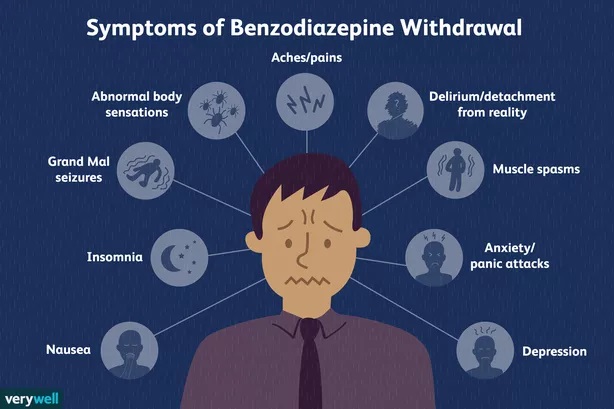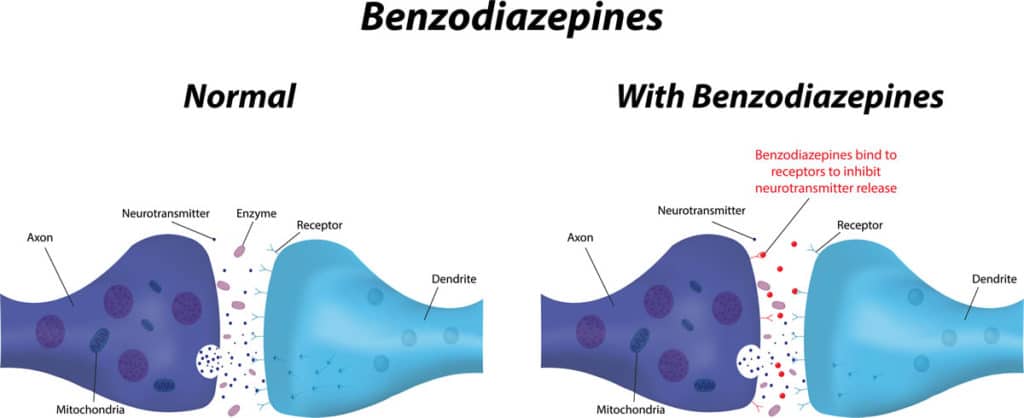World Benzodiazepine Awareness Day was July 11. By Our Student Pharmacist, Torie VonSeggern.
World Benzodiazepine Awareness Day was observed on July 11 to educate patients on some of the dangers of long-term use (greater than four weeks) of benzodiazepines (BZDs). This day has been observed since 2016, when a group of people who had been injured with BZDs joined together to educate others on the risks.
What Are Benzodiazepines?
BZDs are sedative-hypnotic medications (to induce calm and sleep) that are used for a variety of health conditions, such as anxiety, insomnia, and seizures.
In almost all health conditions BZDs are not the first choice of treatment due to the risks that are associated in comparison to other treatments available. When a BZD is selected for treatment of a health condition, the shortest length of treatment possible should be selected to reduce harm.
There are many BZDs available and they are typically classified by the length of time that the drug is active in the body. This classification is defined by the half-life (length of time necessary for the amount of active drug in the body to decrease by half) and is divided into three categories:
- short (2 to 5 hours)
- intermediate (6 to 24 hours)
- long (greater than 24 hours)
Short-acting BZDs have an increased risk of withdrawal symptoms as the drug leaves the body much faster than long-acting BZDs which stay in the body for a longer time.
| Short (2 to 5 hours)
★ Midazolam (Nayzilam) ★ Remimazolam (Byfavo) ★ Triazolam (Halcion) |
Intermediate (6 to 24 hours)
★ Alprazolam (Xanax) ★ Estazolam (Prosom) ★ Lorazepam (Ativan) ★ Oxazepam (Serax) ★ Temazepam (Restoril) |
Long (>24 hours)
★ Chlordiazepoxide (Librium) ★ Clobazam (Onfi; Sympazan) ★ Clonazepam (Klonopin) ★ Clorazepate (Tranxene-T) ★ Diazepam (Valium) ★ Flurazepam (Dalmane) ★ Quazepam (Doral) |
What Are the Dangers of Long-Term Use?
BZDs are often associated with physical dependence and misuse even when taken for a short period of time and in small doses.
Some risks associated with BZDs include side effects and withdrawal symptoms (caused by physical dependence) when stopping the medication.
Some possible side effects include:
- Drowsiness
- Memory impairment
- Irritability
- Changes in appetite
- Changes in weight
There are a variety of withdrawal symptoms ranging from mild to severe that may occur when discontinuing BZDs.
| Mild (2 to 3 days)
★ Anxiety ★ Insomnia |
Moderate (2 to 14 days)
★ Sleep disturbance ★ Anxiety and Irritability ★ Tremors ★ Nausea/Vomiting ★ Headache/Poor concentration ★ Weight loss ★ Palpitations ★ Muscle pain and stiffness |
Severe (2 to 14 days)
★ Seizure ★ Psychosis |
When discontinuing a BZD it is important to work with your healthcare provider to create a plan to slowly discontinue the medication. The dose should slowly decrease by about 25 to 50 percent every one to two weeks over about six to ten weeks.
Some risk factors that may increase the risk of seizures include previous brain damage and alcohol misuse. In some cases, discontinuation may need to be done inpatient (hospital or other care facility) if the patient has not been able to discontinue in the past or has risk factors for severe withdrawal.
Why is Awareness Important?
Based on a study between 2015 and 2016, over 30.6 million adults in the U.S. reported BZD use over the past year; that was nearly 12.6% of the U.S. population. Since such a significant percentage of the population takes BZDs, it is important to recognize the signs and symptoms that may occur with BZD use along with signs and symptoms of dependence. It is also important to recognize that due to some of the risks with withdrawal it is important to consult a healthcare professional before discontinuing.
What can you do with this information?
Although BZDs can be beneficial in short-term use, there are many concerns and dangers of long-term use. Being informed about the risks and the signs of misuse is one of the best ways to protect yourself and those around you. Understanding the best steps to take when discontinuing a BZD is important to prevent withdrawal symptoms such as slowly stopping the medication by taking smaller doses over a period of time with the direction of a healthcare provider.
If you have questions or concerns please reach out to your pharmacist or primary care provider!
If you would like some additional information, medlineplus.gov is a reliable resource for health related information regarding health conditions, drugs and supplements, and other medically related topics.
References
- Craske, Michelle, Bystritsky, Alexander. “Generalized Anxiety Disorder in Adults: Management.” UpToDate, 12 November 2021, https://www.uptodate.com/contents/generalized-anxiety-disorder-in-adults-management?search=benzodiazepines%20anxiety&source=search_result&selectedTitle=1~150&usage_type=default&display_rank=1#H3281817958
- Greller, Howard and Gupta, Amit. “Benzodiazepine Poisoning and Withdrawl.” UpToDate, 20 October, 2020, https://www.uptodate.com/contents/benzodiazepine-poisoning-and-withdrawal?search=benzodiazepines&source=search_result&selectedTitle=2~145&usage_type=default&display_rank=1
- Lembke, Anna. “Benzodiazepines: Our Other Prescription Drug Epidemic.” STAT News, 22 February 2018, https://www.statnews.com/2018/02/22/benzodiazepines-drug-epidemic/comment-page-3/
- Mohsin, Haroon. “World Benzodiazepine Awareness Day – July 11, 2022.” National Today, 3 June 2022, https://nationaltoday.com/world-benzodiazepine-awareness-day/.
- Neubauer, David. “Pharmacotherapy for Insomnia in Adults.” UpToDate, 18 May 2022, https://www.uptodate.com/contents/pharmacotherapy-for-insomnia-in-adults?search=benzodiazepines%20insomnia&source=search_result&selectedTitle=1~150&usage_type=default&display_rank=1#H2498605024
- O’Keefe Osborn, Corinne. “How Long Does Withdrawal from Benzodiazepines Last?” VeryWell Mind, 5 November 2021, https://www.verywellmind.com/benzodiazepine-withdrawal-4588452
- Park, Tae Woo. “Benzodiazepine Use Disorder.” UpToDate, 5 July 2022, https://www.uptodate.com/contents/benzodiazepine-use-disorder?search=benzodiazepines%20long%20term%20use&source=search_result&selectedTitle=1~150&usage_type=default&display_rank=1#H3665649057
- Schachter, Steven. “Antiseizure Medications: Mechanism of Action, Pharmacology, and Adverse Effects.” UpToDate, 25 April 2022, https://www.uptodate.com/contents/antiseizure-medications-mechanism-of-action-pharmacology-and-adverse-effects?search=benzodiazepines%20seizures&source=search_result&selectedTitle=2~150&usage_type=default&display_rank=2#H1
- “What are the Signs Someone is Addicted to Benzos?” Cornerstone of Recovery, 3 March 2020, https://www.cornerstoneofrecovery.com/what-are-the-signs-someone-is-addicted-to-benzos/




